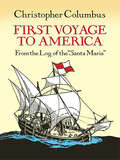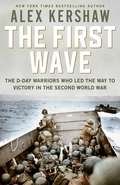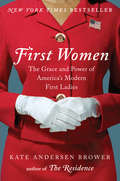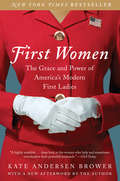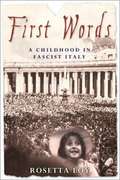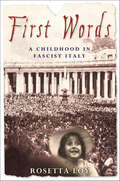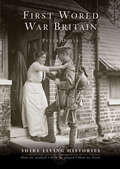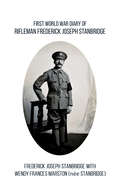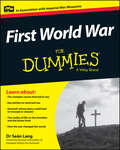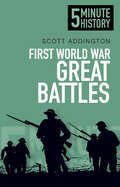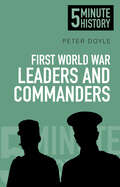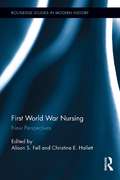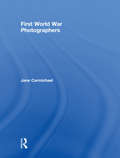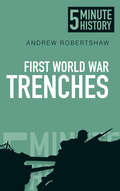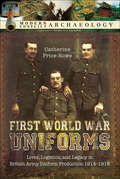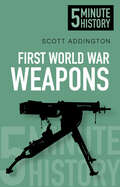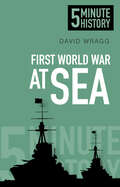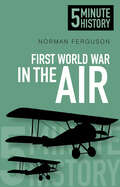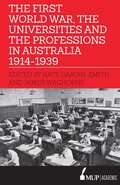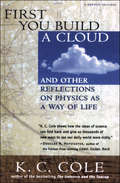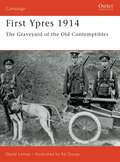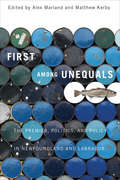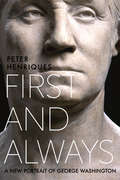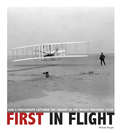- Table View
- List View
First Voyage to America: From the Log of the "Santa Maria" (Dover Children's Classics)
by Christopher ColumbusDramatic, revealing entries -- including Columbus' own words -- document epochal voyage, heavy seas, discouraged crew, first sighting of land, appearance of island natives, more. Translated into English, reset in large type. 44 illustrations, including a number from rare sources. Fascinating historical document. Publisher's note.
First Wave: The D-Day Warriors Who Led the Way to Victory in the Second World War
by Alex Kershaw'History’s greatest story reinvigorated as only Alex Kershaw can' —Adam Makos, New York Times bestselling author of A Higher Call'An absolute triumph' —James M. Scott, Pulitzer Prize Finalist and national bestselling author of Target Tokyo and Rampage'The unforgettable human drama of history's most consequential invasion' —John C. McManus, author of The Dead and Those About to Die: D-Day—The Big Red One at Omaha Beach Beginning in the pre-dawn darkness of June 6, 1944, The First Wave follows ten men attempting to carry out D-Day's most critical missions. Their actions would determine the fate of the invasion of Hitler's Fortress Europe. The ten make a charismatic, unforgettable cast. They include the first American paratrooper to touch down on Normandy soil; the only British soldier that day to earn a Victoria's Cross; the Canadian brothers who led their decimated troops onto Juno Beach under withering fire; the colonel who faced the powerful 150mm guns of the Merville Battery; as well as a French commando who helped destroy German strongholds on Sword Beach. The book will give authentic voice to the invaders' enemies, the German enlisted men and officers tasked with destroying the Allies as they hit the beaches. The result is an utterly immersive, adrenaline-driven drama, an epic of close combat and extraordinary heroism. It is the capstone Alex Kershaw's remarkable career, built on his close friendships with D-Day survivors and his intimate understanding of the Normandy battlefield. For the seventy-fifth anniversary, here is a fresh take on the Second World War's longest day.Praise for Alex Kershaw: ‘From the opening pages, when Kershaw...drops us into the invasion of Paris, we know that we are in good hands. This is classic narrative nonfiction, constructed and written like a thriller.’ Chicago Tribune ‘Exceptional.... balances evocative prose with attention to detail and is a worthy addition to vibrant classics of small-unit history like Stephen Ambrose's Band of Brothers.’ Wall Street Journal ‘Kershaw's writing is seamless. He incorporates information from a vast array of sources, but it works--you get a sense of the different voices coming into the story....A gripping read.’ Minneapolis Star Tribune
First Women: The Grace and Power of America's Modern First Ladies
by Kate Andersen Brower<P>From the #1 New York Times bestselling author of the groundbreaking backstairs look at the White House, The Residence, comes an intimate, news-making look at the true modern power brokers at 1600 Pennsylvania Avenue: the First Ladies, from Jackie Kennedy to Michelle Obama. <P>One of the most underestimated--and challenging--positions in the world, the First Lady of the United States must be many things: an inspiring leader with a forward-thinking agenda of her own; a savvy politician, skilled at navigating the treacherous rapids of Washington; a wife and mother operating under constant scrutiny; and an able CEO responsible for the smooth operation of countless services and special events at the White House. Now, as she did in her smash #1 bestseller The Residence, former White House correspondent Kate Andersen Brower draws on a wide array of untapped, candid sources--from residence staff and social secretaries to friends and political advisers--to tell the stories of the ten remarkable women who have defined that role since 1960. <P>Brower offers new insights into this privileged group of remarkable women, including Jacqueline Kennedy, Lady Bird Johnson, Patricia Nixon, Betty Ford, Rosalynn Carter, Nancy Reagan, Barbara Bush, Hillary Clinton, Laura Bush, and Michelle Obama. The stories she shares range from the heartwarming to the shocking and tragic, exploring everything from the first ladies' political crusades to their rivalries with Washington figures; from their friendships with other first ladies to their public and private relationships with their husbands. She also offers a detailed and insightful new portrait of one of the most-watched first ladies of all time, Hillary Clinton, asking what her tumultuous years in the White House may tell us about her own historic presidential run . . . and what life could be like with the nation's first First Husband. <P>Candid and illuminating, this first group biography of the modern first ladies provides a revealing look at life upstairs and downstairs at the world's most powerful address. <P><b>A New York Times Bestseller</b>
First Women: The Grace and Power of America's Modern First Ladies
by Kate Andersen BrowerFrom the #1 New York Times bestselling author of the groundbreaking backstairs look at the White House, The Residence, comes an intimate, news-making look at the true modern power brokers at 1600 Pennsylvania Avenue: the First Ladies, from Jackie Kennedy to Michelle Obama and Melania Trump.One of the most underestimated—and challenging—positions in the world, the First Lady of the United States must be many things: an inspiring leader with a forward-thinking agenda of her own; a savvy politician, skilled at navigating the treacherous rapids of Washington; a wife and mother operating under constant scrutiny; and an able CEO responsible for the smooth operation of countless services and special events at the White House. Now, as she did in her smash #1 bestseller The Residence, former White House correspondent Kate Andersen Brower draws on a wide array of untapped, candid sources—from residence staff and social secretaries to friends and political advisers—to tell the stories of the ten remarkable women who have defined that role since 1960.Brower offers new insights into this privileged group of remarkable women, including Jacqueline Kennedy, Lady Bird Johnson, Patricia Nixon, Betty Ford, Rosalynn Carter, Nancy Reagan, Barbara Bush, Hillary Clinton, Laura Bush, and Michelle Obama. The stories she shares range from the heartwarming to the shocking and tragic, exploring everything from the first ladies’ political crusades to their rivalries with Washington figures; from their friendships with other first ladies to their public and private relationships with their husbands. She also offers insight as to what Melania Trump might hope to accomplish as First Lady.Candid and illuminating, this first group biography of the modern first ladies provides a revealing look at life upstairs and downstairs at the world’s most powerful address.
First Words: A Childhood in Fascist Italy
by Gregory Conti Rosetta Loy<P>In 1937, Rosetta Loy was a privileged five-year-old growing up among the well-to-do Catholic intelligentsia of Rome. But her childhood world of indulgent nannies and summers in the mountains was also the world of Mussolini's fascist regime and the increasing oppression of Italian Jews. <P>Loy interweaves the two Italys of her early years, revealing the willful ignorance of her own family as one by one their Jewish neighbors disappeared. She indicts journalists and intellectuals for their blindness and passivity, and presents a searing and dispassionate record of the role of the Vatican and Catholic leadership in the devastation of Italian Jewry.
First Words: A Childhood in Fascist Italy
by Rosetta LoyAn internationally acclaimed novelist and journalist movingly chronicles her childhood in Rome during World War II, providing a rare account by a Catholic of Jewish persecution and Papal responsibility In 1937, Rosetta Loy was a privileged five-year-old growing up in the heart of the well-to-do Catholic intelligentsia of Rome. But her childhood world of velvet and lace, airy apartments, indulgent nannies, and summers in the mountains was also the world of Mussolini's fascist regime and the increasing oppression of Italian Jews. Loy interweaves the two Italys of her early years, shifting with powerful effect from a lyrical evocation of the many comforts of her class to the accumulation of laws stipulating where Jews were forbidden to travel and what they were not allowed to buy, eat, wear, and read. She reveals the willful ignorance of her own family as one by one their neighbors disappeared, and indicts journalists and intellectuals for their blindness and passivity. And with hard-won clarity, she presents a dispassionate record of the role of the Vatican and the Catholic leadership in the devastation of Italy's Jews.Written in crystalline prose, First Words offers an uncommon perspective on the Holocaust. In the process, Loy reveals one writer's struggle to reconcile her memories of a happy childhood with her adult knowledge that, hidden from her young eyes, one of the world's most horrifying tragedies was unfolding.
First World War Britain
by Peter DoyleWhen Britain declared war on Germany in August 1914, most expected the war to be over by Christmas, and only a handful forecast the length of the conflict, or the impact it would have on a civilian population whose experience of war to date had been reading of the exploits of the British Army in distant Sudan or South Africa. The First World War would change British society, often irrevocably and sometimes for the better, but it also brought hardship and fear. Rationing, government restrictions, censorship, and bombardment from both the sea and air, meant that for the first time, civilians found themselves part and sometimes victims, of 'total war'. Shopkeepers might boast that it was business as usual, but nobody could ignore the social upheaval, the restrictions introduced by new legislation or the strains and privations facing day-to-day existence. Nonetheless, the war also saw Britain galvanise itself in a collective effort to increase industrial productivity, domestic self-sufficiency and reduce waste - all key factors in helping to win the war. Lucinda Gosling explores how the people left at home adapted their lifestyles to meet the challenges of the time, looking at the minutiae of everyday life such as rationing-influenced recipes and popular toys, alongside broader issues like food shortages and industrial unrest.
First World War Diary of Rifleman Frederick Joseph Stanbridge
by Frederick Joseph StanbridgeSomewhere in Palestine March 10th, 1918 My Very Dear Brother Ern, ….since receiving your last letter, I have been "over the top". I was expecting to have to go, but I assure you Ern, I never dreamed it would be so terrible!… I want to try to forget those certain 16 hours, but I cannot, and I am afraid I never shall. I really think the night of February 19-20th was (for me anyhow) a night in hell. We had to attack Johnny with the bayonet in the dark about 1:30 (and it was dark too). He was stronger than expected. If our machine guns had not come up just in time, I think we would all have been wiped out.
First World War For Dummies
by Seán LangFrom the Somme to Gallipoli to the home front, First World War For Dummies provides an authoritative, accessible, and engaging introduction to the War to End All Wars. It takes a global perspective of this global conflict, proving insight into the actions and motivations of the participants and how each nation’s story fits into the wider one. Coverage also includes: The origins of the war and a snapshot of what the world looked like at the beginning of the 20th century The battles of Western Europe, and action in the Southern and Eastern Fronts The war at home — the civilian war, propaganda, opposition, politics, protests, and more 1918: The German spring offensive, the Allied success and the beginning of the end The Treaty of Versailles, the League of Nations, and the effect on the future First World War For Dummies is the go-to source for readers seeking to learn more about the fundamental event of the 20th century.
First World War Great Battles: 5 Minute History (5 Minute History)
by Scott AddingtonHow did the First World War start? Who were the main players? Where did the fighting begin? And why were there so many casualties? If the 100-year anniversary of this war to end all wars has left you feeling a little under-informed, Five Minute History is the perfect way to read up on this major conflict in short bursts and without pages of intricate detail. A perfect overview for the uninitiated, each book will inform and educate you of the ups and downs of the First World War even if you have never read a history book in your life.
First World War Leaders and Commanders: 5 Minute History
by Peter DoyleHow much can you really find out about the Leaders and Commanders of the First World War in five minutes? This handy little history book will surpass all your expectations and leave you well versed on all you wish to know, and maybe even a little bit more… Who were the leaders? Who commanded the British Army on the Somme? Which general committed suicide in shame? Who stopped the German offensive at Verdun? Who invented stormtroopers? Jam-packed with facts and first-hand accounts of the action, all woven together in an accessible way by an expert in the field, this 5 Minute History is a valuable addition to anyone’s bookshelf, ready to be delved into at a moment’s notice.
First World War Nursing: New Perspectives (Routledge Studies in Modern History #11)
by Christine E. Hallett Alison S. FellThis book brings together a collection of works by scholars who have produced some of the most innovative and influential work on the topic of First World War nursing in the last ten years. The contributors employ an interdisciplinary collaborative approach that takes into account multiple facets of Allied wartime nursing: historical contexts (history of the profession, recruitment, teaching, different national socio-political contexts), popular cultural stereotypes (in propaganda, popular culture) and longstanding gender norms (woman-as-nurturer). They draw on a wide range of hitherto neglected historical sources, including diaries, novels, letters and material culture. The result is a fully-rounded new study of nurses’ unique and compelling perspectives on the unprecedented experiences of the First World War.
First World War Photographers
by Jane CarmichaelFirst Published in 1989. Routledge is an imprint of Taylor & Francis, an informa company.
First World War Trenches: 5 Minute History (5 Minute History)
by Andrew RobertshawHow much can you really find out about the Trenches of the First World War in five minutes? This handy little history book will surpass all your expectations and leave you well versed on all you wish to know, and maybe even a little bit more… Was it always muddy? Was every minute spent under fire? How did they get around? What food was eaten? And how did they build them anyway? Jam-packed with facts, stats and first-hand accounts of the action, all woven together in an accessible way by an expert in the field, this 5 Minute History is a valuable addition to anyone’s bookshelf, ready to be delved into at a moment’s notice.
First World War Uniforms: Lives, Logistics, and Legacy in British Army Uniform Production, 1914–1918 (Modern Conflict Archaeology)
by Catherine Price-RoweView any image of a Tommy and his uniform becomes an assumed item, few would consider where and how that uniform was made. Over 5 million men served on the Western Front, they all required clothing. From August 1914 to March 1919, across all theaters of operations, over 28 million pairs of trousers and c.360 million yards of various cloth was manufactured.Worn by men of all ranks the uniform created an identity for the fighting forces, distinguished friend from foe, gave the enlisted man respect, a sense of unity whilst at the same time stripping away his identity, turning a civilian into a soldier. Men lived, worked, slept, fought and died in their uniform.Using the authors great-grandfather's war service as a backdrop, this book will uncover the textile industries and home front call to arms, the supply chain, salvage and repair workshops in France, and how soldiers maintained their uniform on the front line.Items of a soldiers uniform can become a way to remember and are often cherished by families, creating a tangible physical link with the past, but the durability of cloth to withstand time can create an important legacy. The fallen are still discovered today and remnants of uniform can help to identify them, at the very least the color of cloth or type of hob nail can give the individual his nationality allowing them to be given a final resting place.
First World War Weapons: 5 Minute History
by Scott AddingtonHow did the First World War start? Who were the main players? Where did the fighting begin? And why were there so many casualties? If the 100-year anniversary of this war to end all wars has left you feeling a little under-informed, Five Minute History is the perfect way to read up on this major conflict in short bursts and without pages of intricate detail. A perfect overview for the uninitiated, each book will inform and educate you of the ups and downs of the First World War even if you have never read a history book in your life.
First World War at Sea: 5 Minute History
by David WraggHow much can you really find out about the War at Sea during the First World War in five minutes? This handy little history book will surpass all your expectations and leave you well versed on all you wish to know, and maybe even a little bit more… Which was stronger, the German or British navy? What was the biggest battle? Who were the heroes? Who led the navies? And how successful were they? Jam-packed with facts, stats and first-hand accounts of the action, all woven together in an accessible way by an expert in the field, this 5 Minute History is a valuable addition to anyone’s bookshelf, ready to be delved into at a moment’s notice.
First World War in the Air: 5 Minute History
by Norman FergusonHow much can you really find out about the War in the Air during the First World War in five minutes? This handy little history book will surpass all your expectations and leave you well versed on all you wish to know, and maybe even a little bit more… Who was the highest-scoring ace? Which plane looked like a dog begging? What was the Black Flight? How many died in the first Blitz? What was the Fokker Scourge? Jam-packed with facts, stats and first-hand accounts of the action, all woven together in an accessible way by an expert in the field, this 5 Minute History is a valuable addition to anyone’s bookshelf, ready to be delved into at a moment’s notice.
First World War, the Universities and the Professions in Australia 1914-1939
by Kate Darian-Smith James WaghorneAustralia's extraordinary contribution to World War I extended well beyond its military forces to the expertise of its universities and professional men and women. Scientists and engineers oversaw the manufacture of munitions and the development of chemical weapons. Doctors sustained soldiers in the trenches, and treated the physically and psychologically damaged. Public servants, lawyers and translators were employed in the war bureaucracy, while artists and writers found new modes to convey the trauma of war. The graduates and staff of Australia's six universities—Sydney, Melbourne, Adelaide, Tasmania, Queensland and Western Australia and Queensland—were involved in this expansion of expertise. But what did these men and women do after the guns were silenced? How were the professions and universities transformed by the immediate and longer-term impacts of the war? The First World War, the Universities and the Professions examines how the technical and conceptual advances that occurred during World War I transformed Australian society. It traces the evolving role of universities and their graduates in the 1920s and 1930s, the increasing government validation of research, the expansion of the public service, and the rise of modern professional associations and international networks. While the war contributed to greater specialisations in traditional professions such as teaching or medicine, it also stimulated new jobs and training—whether in economics, anthropology or graphic art. This volume provides a new account of the interwar years that places knowledge and expertise at the heart of the Australian story. Its four sections—The Medical Sciences; Science and Technology; Humanities, Social Sciences and Teaching; and The Arts: Design, Music and Writing—highlight how World War I disrupted and shaped the careers of individuals as well as the development of Australian society and institutions.
First You Build a Cloud: And Other Reflections on Physics as a Way of Life
by K. C. ColeThis clearly written and compelling look at physics and physicists offers &“thousands of new ways to see our daily world more richly&” (Douglas Hofstadter, author of Gödel, Escher, Bach). For many of us, physics has always been a thing of mystery and complexity. K. C. Cole, an award-winning science writer, specializes in making its wonders accessible to the everyday reader. This book uses lively prose, metaphors, and anecdotes to allow us to comprehend the nuances of physics: gravity and light, color and shape, quarks and quasars, particles and stars, force and strength. It also shows us how the physical world is so deeply intertwined with the ways we think about culture, poetry, and philosophy, and explores the workings of such legendary scientific minds as Richard Feynman, Victor Weisskopf, brothers Frank Oppenheimer and J. Robert Oppenheimer, Philip Morrison, Vera Kistiakowsky, and Stephen Jay Gould. &“An exemplary science writer . . . For readers without scientific background, Cole gracefully introduces relativity, quantum theory, optics, astrophysics, and other significant disciplines, never getting bogged down in unnecessary explanation. Thus, you may not learn all about thermodynamics from reading her chapter on it, but you will learn enough to think seriously about the entropy in your own life. Cole sprinkles her text with comments from famous scientists—&‘Space is blue, and birds fly in it,&’ said Heisenberg, and Faraday said, &‘Nothing is too wonderful to be true&’—that are not only delightful in themselves but perfectly suited to her own text. No review of Cole&’s book could be too wonderful to be true.&” —Booklist
First Ypres 1914
by Ed Dovey David LomasOsprey's overview of the First Battle of Ypres of World War I (1914-1918). In the autumn of 1914 the original British Expeditionary Force faced a heavily reinforced German drive. Field Marshal Sir John French, the British Commander-in-Chief, had sent his men north in an attempt to take the fight into Flanders, so they could fight across open ground. History tells us that this was not to be the case. David Lomas chronicles the first of the trench-warfare battles, where lines that would remain almost static for the rest of the war were established. Although the Germans failed to reach the channel ports, the death knell had rung for the BEF, which was virtually wiped out in this brave defence.
First among Unequals: The Premier, Politics, and Policy in Newfoundland and Labrador
by Alex Marland Matthew KerbyCanadians are told that provincial premiers wield considerable sway. Critics decry premiers as autocrats and dictators, while supporters label them as altruists and great leaders. In Newfoundland and Labrador the premier is expected to be the province's overlord, a patriotic defender of provincial interests, and the decision-maker who brokers competing policy priorities. But does a premier have as much power over government policy decisions as is popularly believed? First among Unequals, a detailed enquiry into the administration of Premier Danny Williams and the first year of his successor Kathy Dunderdale, suggests that the power of the premier is exaggerated by the media, critics, political parties, the public service, and the leaders themselves. With perspectives from economics, education, geography, health policy, history, and political science, contributors explore how dominant Williams was and test theories to show how power operates in provincial governments. They examine politics and government through case studies of the healthcare sectors, education, the fisheries, rural and regional development, hydroelectric projects, and the labour market. Focusing on an era of political populism and rapid economic growth, First among Unequals reasons that there is not enough evidence to suggest that the Premier's Office - even with someone like Danny Williams at the helm - independently shapes public policy. Contributors include Karlo Basta (Memorial), Sean Cadigan (Memorial), Angela Carter (Waterloo), Christopher Dunn (Memorial), Jim Feehan (Memorial), Gerald Galway (Memorial), Ryan Gibson (Memorial), James Kelly (Concordia), Royce Koop (Manitoba), Mario Levesque (Mount Allison), Maria Mathews (Memorial), John Peters (Laurentian), Michelle Porter (Memorial), Kate Puddister (McGill), Valérie Vézina (UQAM), and Kelly Vodden (Memorial, Grenfell).
First and Always: A New Portrait of George Washington
by Peter R. HenriquesGeorge Washington may be the most famous American who ever lived, and certainly is one of the most admired. While surrounded by myths, it is no myth that the man who led Americans’ fight for independence and whose two terms in office largely defined the presidency was the most highly respected individual among a generation of formidable personalities. This record hints at an enigmatic perfection; however, Washington was a flesh-and-blood man. In First and Always, celebrated historian Peter Henriques illuminates Washington’s life, more fully explicating his character and his achievements.Arranged thematically, the book’s chapters focus on important and controversial issues, achieving a depth not possible in a traditional biography. First and Always examines factors that coalesced to make Washington such a remarkable and admirable leader, while also chronicling how Washington mistreated some of his enslaved workers, engaged in extreme partisanship, and responded with excessive sensitivity to criticism. Henriques portrays a Washington deeply ambitious and always hungry for public adoration, even as he disclaimed such desires. In its account of an amazing life, First and Always shows how, despite profound flaws, George Washington nevertheless deserves to rank as the nation's most consequential leader, without whom the American experiment in republican government would have died in infancy.
First and Foremost: A Concise Illustrated History of 1st Battalion, the Royal Australian Regiment, 1945 - 2018
by Bob BreenThis history has been published to mark 70 years of service as well as the 50th Anniversary of the battle of Coral/Balmoral in Vietnam in 1968, the 25th Anniversary of service in Somalia in 1993 and the 10th anniversary of service in Afghanistan in 2008/09. It covers only the ‘wave tops’ of 70 years of history and mentions only a few individuals, mostly commanding officers or contingent commanders who had ultimate responsibility for operational success or failure; thus, deserving their prominence. Photographs and tables do their best to enhance the narrative in the expectation of, ‘A picture is worth a 1000 words’. By measures of its operational record, The 1st Battalion, The Royal Australian Regiment is one of the first and foremost battalions of the Royal Australian Regiment.
First in Flight: How a Photograph Captured the Takeoff of the Wright Brothers' Flyer (Captured History)
by Michael BurganOn-point historical photographs combined with strong narration bring the story of the historic first flight ever to life. Kids will feel as though they are at Kitty Hawk with Wilbur and Orville Wright as the brothers prepare to test their aircraft. They'll also learn about the history of flight and the skepticism that greeted the Wrights when they, at first, refused to release the photograph of their successful flight.
